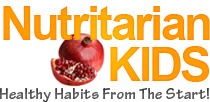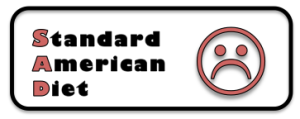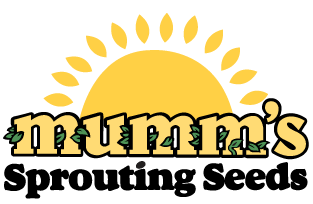Nutritarian Explained
The term “NUTRITARIAN” was coined by Dr. Joel Fuhrman MD who describes his suggested eating style as one where basically we choose to eat more of the foods that contain the highest nutrient content and less of the foods that don’t. Dr. Fuhrman has helped tens of thousands of patients including children overcome multiple significant life threatening illnesses and get off expensive medications just by changing their diets to a more plant based whole foods way of eating.
The reality today is that due to the Standard American Diet (SAD), many children will NOT out live their parents as they are becoming more and more overweight and stricken with preventable diseases such as heart disease and type II diabetes. What’s more is that these days, parents think it’s normal and expected that their children will require antibiotics and other medications at least once a year for sickness. It’s not normal and yet it is accepted as such because of the frequency at which it happens. Does it not seem ridiculous that some of the most common killers in North America (heart disease, type II diabetes and even many cases of cancer) are completely preventable? What are more shocking are the earlier ages at which these problems are developing. The realization of these truths, are what caused me to believe that there must be a better way to help my children grow healthy and strong.
My husband and I decided to adopted this nutritarian, plant based, whole foods way of eating and have been very happy with the results so far. I don’t want to get into all the reasons why eating this way makes sense to us and to be honest, this site wasn’t created to convince you that you should, but I am a firm believer that people need to study things out for themselves and based on the knowledge that rings true to them, make their own decisions. As a start, I HIGHLY recommend reading Dr. Fuhrman’s book, “Disease Proof Your Child: Feeding Kids Right”. Actually, reading any of his books such as “Eat to Live”, “Eat for Health”, “Super Immunity” or “The End of Diabetes”, will be well worth your time. These books create an excellent foundation of knowledge about the relationship between what we eat and how it affects our health, as well as provide guidelines for how to make the transition to this Nutritarian eating style. It was however the book “Disease Proof Your Child” that really hit home for me because as most parents are, we seem to be more concerned with our children’s well being than our own. Well the best part is that this style is one that benefits all members of the family from the youngest to the oldest.
Transitioning to this way of eating at first may seem overwhelming so here are the basic nuts and bolts of a nutritarian, whole foods, plant based diet:
Definition of A Healthy Food (By Dr. Fuhrman)
This basically means that a food with the most nutrients and the least amount of calories equals better health. So you want the staple of the diet to be those foods with high nutrient content and less calories. The ANDI score demonstrates which foods are the healthiest by this definition and it shows that green leafy vegetables and deeply colored fruits & vegetables are it.
Food Pyramid
Dr. Fuhrman has created his own version of the food pyramid, which basically flips the conventional food pyramid on its head and looks something like this:
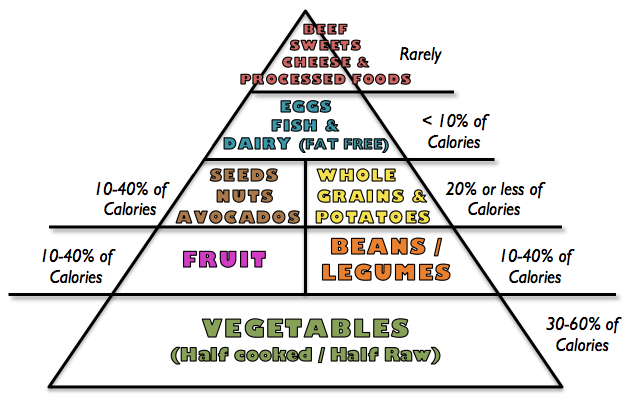
If you want to see the official version, you can check it out on HERE.
Nutrient Density:
When we talk about “nutrients”, most people think of the three MACRO-nutrients: Proteins, Carbohydrates, and Fats. Although these are important calorie sources to give us energy and components for building body tissues, it’s important to also include discussion about MICRO-nutrients such as vitamins, minerals and also enzymes, antioxidants and other phytochemicals that help body cells to perform their intended functions properly and strengthen our immune systems. In the past, the three macronutrients were the main focus along with certain vitamins and mineral supplements*, but today research has shown that there is a lot more into building good health than just these overemphasized components (which we tend to eat too much of and from the wrong sources.) Phytochemicals exist in nutrient dense foods that can help to prevent and or combat life-threatening illnesses such as heart disease, diabetes, and cancer.
Although these are important calorie sources to give us energy and components for building body tissues, it’s important to also include discussion about MICRO-nutrients such as vitamins, minerals and also enzymes, antioxidants and other phytochemicals that help body cells to perform their intended functions properly and strengthen our immune systems. In the past, the three macronutrients were the main focus along with certain vitamins and mineral supplements*, but today research has shown that there is a lot more into building good health than just these overemphasized components (which we tend to eat too much of and from the wrong sources.) Phytochemicals exist in nutrient dense foods that can help to prevent and or combat life-threatening illnesses such as heart disease, diabetes, and cancer. 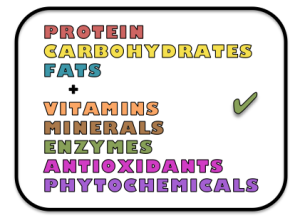
*As a note, minerals and vitamins are generally safer when given in the whole food form rather than as an isolated supplement.
(There are a few exceptions where supplementation is recommended such as Vitamin D for northern climates, DHA and zinc but you can learn more about that from Dr. Fuhrman himself).
More on nutrient density from Dr. Fuhrman HERE
A Set of Guidelines:
When we create recipes and meals for our family, we do our best to stick to the following guidelines:
| VEGETABLES (raw & cooked) |
|
| BEANS/LEGUMES |
|
| SALT |
|
| SUGAR |
|
| OILS |
|
| FLAX, CHIA or HEMPSEEDS |
|
| GRAINS |
|
| DAIRY |
|
| ANIMAL PRODUCTS |
|
| DESSERTS |
|
| “G-BOMBS” for super immunity |
|
|
“SALAD IS THE MAIN DISH” |
|
You are probably now thinking, so what am I going to feed my kids? Well that is exactly what this website is about! Here you will find suggestions and tips, recipes and ideas for creating meals that your kids and entire family can enjoy. The recipes include home made salad dressings and dips, tasty snacks, comforting vegetable soups, hearty dinner ideas, fruit based deserts and refreshing green smoothies & drinks. We are not perfect and we don’t eat perfectly all of the time but we do our best and feel good each time that we make a better choice.
If you are still worried about making such a change, please see my post on Picky Eaters & The Transition from the Standard American Diet to a more whole foods plant based one HERE or if you would like more information about Nutritarian eating, you can visit Dr. Fuhrman’s website HERE.
